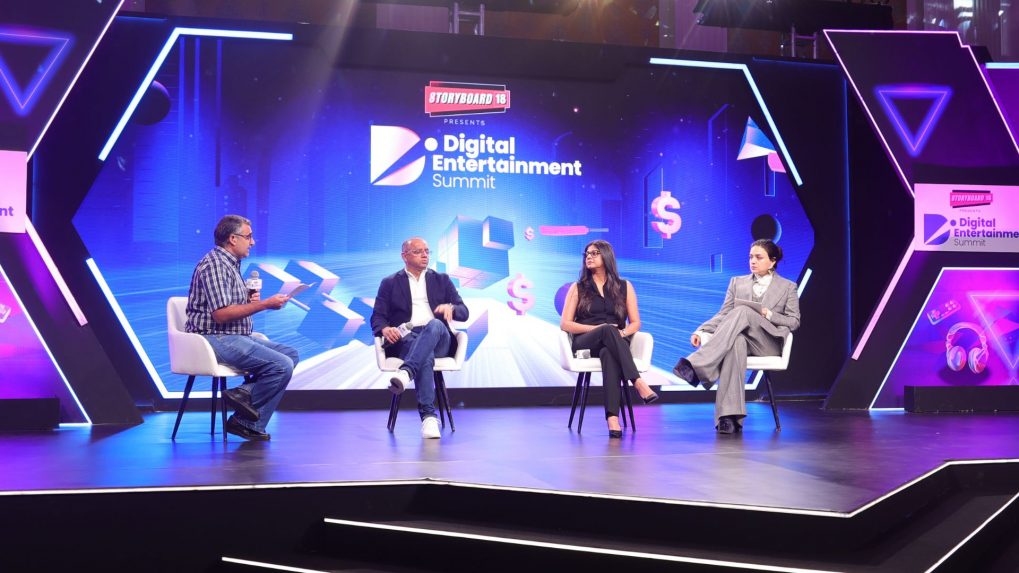Is gaming the new Bollywood? Experts call gaming key contributor to India's trillion dollar economy
Industry experts Roland Landers, CEO, All India Gaming Federation; Salone Sehgal, founder and managing partner, Lumikai; and Meghna Bal, director, ESYA Centre engaged in a conversation on 'Online gaming - A key contributor to India's trillion dollar economy' with moderator Ashish Pherwani, leader, media & entertainment sector, EY India at the Storyboard18's Digital Entertainment Summit 2025.
ADVERTISEMENT
India’s gaming industry, already one of the fastest-growing sectors in the country’s media and entertainment (M&E) landscape, is poised for explosive growth with projections placing its value at over $9 billion by 2029, up from $3.8 billion. Industry experts Roland Landers, CEO, All India Gaming Federation; Salone Sehgal, founder and managing partner, Lumikai; and Meghna Bal, director, ESYA Centre engaged in a conversation on 'Online gaming - A key contributor to India's trillion dollar economy' with moderator Ashish Pherwani, leader, media & entertainment sector, EY India at the Storyboard18's Digital Entertainment Summit 2025.
With 450–480 million active gamers, India is now home to one in every three people playing games annually. Fueled by cheap data, affordable smartphones and widespread mobile access, gaming has evolved into a primary entertainment destination, rivaling OTT platforms, bollywood and even cricket in consumer mindshare. “Gaming is already bigger than cricket revenues. Bigger than the box office. We’ve moved from family screens to personalized screens. Gaming is immersive, participatory, and it’s here to stay,” Salone Sehgal said.
Bharat leads the charge!
Interestingly, the heart of India’s gaming boom isn’t in metros, but in Tier 2 and 3 cities, which contribute to 75% of the user base. With over 550 million smartphone users, the country is on track to reach 830 million gamers within five years. “That expansion is happening, and it’s being led by Bharat. Half a billion gamers… that is going to be intact,” Landers suggested.
Panelists stressed that gaming shouldn’t be viewed solely as entertainment. It is increasingly being used for education, health, upskilling and social interaction. “Gaming isn’t just fun. It’s motivation, education and skill-building. We saw 32 million users for KBC Play-Along and over 100 million for IPL prediction games,” Pherwani added.
Meghna Bal highlighted that fantasy sports, in particular, have emerged as powerful cultural and commercial ecosystems akin to March Madness in the U.S., which drives billions in revenue for universities. Gaming has also become a significant employment generator, with 2.5 lakh people currently working in the industry with 1,900 game development studios in India.
Experts also drew comparisons to the early 1990s TV industry, where it took 5–6 years for homegrown content to thrive post-liberalization. Gaming, they said, is on a similar path. “Just like we moved from Bold and the Beautiful to Family Man, our game development scene will find its Indian voice,” Sehgal noted.
Regulation: Boon or Bane?
While growth is undeniable, several speakers raised red flags around overregulation, citing the TRAI’s 2004 clampdown that stunted innovation in Indian television for two decades. Similar fears now loom over gaming. “If you’re talking about the future of any industry in India, you have to think about regulation and is is going to kill it,” Bal said.
Specifically, the Digital Personal Data Protection Act, which prohibits targeted advertising to children, may devastate kids’ gaming content. “When Google implemented similar rules, it led to massive app abandonment. Blanket bans without nuance lead to unintended consequences,” Bal added.
The discussion concluded with a firm pushback against narratives painting gaming as a public health crisis. Experts pointed out that lack of public spaces, pollution and limited outdoor access in cities like Delhi make mobile-based entertainment the most feasible option.
With India’s gaming industry expected to double in value within five years, experts agree that sustainable growth hinges on three things, first balanced and future-ready regulation; second ecosystem-wide investment in game development and infrastructure; and third greater public awareness of gaming’s multidimensional value.
Read More: Gaming needs its ‘RRR' moment! Experts on gaming as India's next soft power

